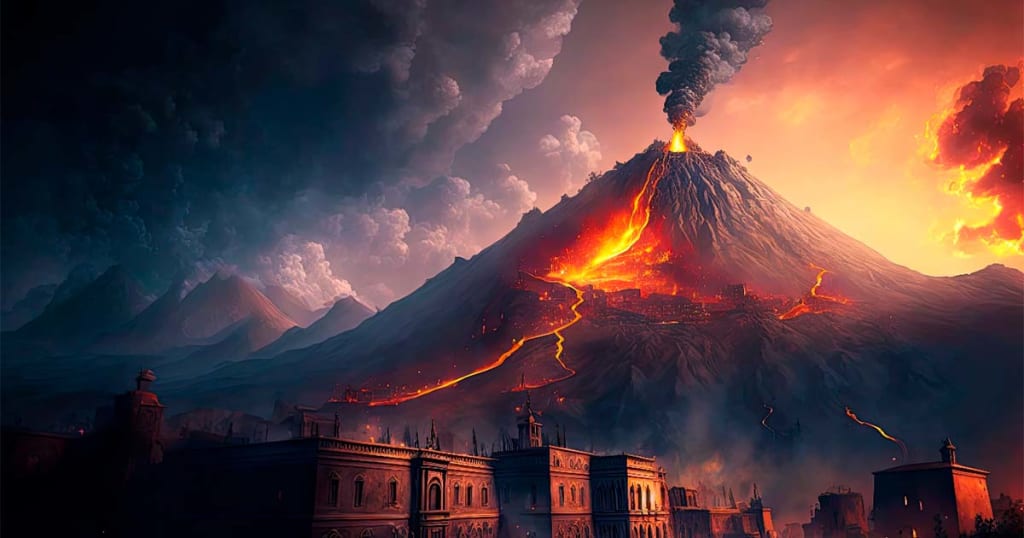Exploring the Emotions and Mysteries of Pompeii's Tragic End
Pompeii's Volcano Mystery

Introduction:
Pompeii, an ancient Roman city buried under volcanic ash after the eruption of Mount Vesuvius in 79 AD, holds a unique place in history. Unlike other archaeological sites, Pompeii offers us a glimpse into the human element of a catastrophic event. The preserved remains of its inhabitants reveal their emotions and actions during their final moments, making it a source of fascination for people worldwide.
Unveiling the Human Element:
Pompeii provides an intimate window into the lives of its residents, showcasing their emotions and reactions in the face of impending doom. As we explore the ruins, we can see them in the context of their own living spaces, whether they were hiding, attempting to flee, or rescuing loved ones. This connection with real people from the past creates a powerful and emotional experience for visitors.
The Mystery of Their Deaths:
Although Pompeii showcases the human element, many mysteries surround the exact circumstances of how its inhabitants perished. One intriguing discovery is a group of 15 bodies found together in the eastern part of the city. These bodies were in odd positions, suggesting a possible effort to assist or find solace one another during their final moments.
A cloud of volcanic gas and debris rolled down the slopes of Mount Vesuvius. Smoke, ash, and debris fell on Pompeii, trapping people in their homes. Six surges of hot gas killed those who were left. In just 18 hours, Pompeii was buried under volcanic ash and pumice. Thousands of people were buried alive. Their bodies left voids in the ground as they decomposed. Archaeologists filled these voids with plaster to reveal the shapes of the bodies. The casts they made have fascinated the world.
Delving into the Investigation:
To unravel the mysteries surrounding these bodies, a team of scientists is currently conducting a detailed study. Led by Lawrence Alem, the team aims to understand the precise events that led to the peculiar positioning of the bodies and the story behind their deaths. By analyzing various aspects such as skeletal remains, injuries, and contextual evidence, they hope to uncover more information about what transpired during the eruption.
The Power of Collaboration:
Alem's team has found the groupings of bodies intriguing, with clusters of three or four individuals found together. This suggests that these people may have been helping each other, possibly trying to escape or seeking comfort in their final moments. The team's collaborative effort seeks to shed light on the nature of their relationships and the actions they took as the disaster unfolded.
The discovery of the scrolls in the buried city of Herculaneum posed a great challenge to and archaeologists. These delicate ancient documents, affected by the volcanic ash and high temperature of the eruption, were extremely fragile. Scholars attempted various techniques to unravel their secrets, but their efforts often resulted in disappointment as the scrolls disintegrated upon touch.
Today, sporting events have become an integral part of our society. Just like the gladiator games in ancient Pompeii, modern-day sporting events bring people together in excitement and anticipation. They provide a platform for athletes to showcase their skills and talent, while also offering an opportunity for spectators to come together and experience the thrill of competition.
Conclusion:
Pompeii's ability to reveal the emotions and humanity of its inhabitants through their preserved remains is what makes it a captivating place for people around the world. As ongoing investigations, such as Lawrence Alem's study of the 15 bodies found in the east of the city, delve deeper into the mysteries of Pompeii, we inch closer to understanding the events that unfolded on that fateful day in 79 AD. By piecing together these stories of tragedy and resilience, we gain a greater appreciation for the human experiences etched within Pompeii's ancient ruins.





Comments
There are no comments for this story
Be the first to respond and start the conversation.